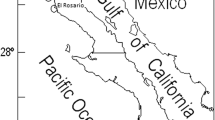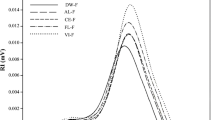The present study aimed to produce a sulfated polysaccharide (fucoidan) from micronized marine algae of the family Fucaceae. The conditions for isolation of the fucoidan were developed and optimized. The number of extractions had the greatest influence on the yield of fucoidan. Dialysis was used for the first time to isolate high-molecular-mass fractions of fucoidan. The liquid fucoidan was lyophilized.
Similar content being viewed by others
Explore related subjects
Discover the latest articles, news and stories from top researchers in related subjects.Avoid common mistakes on your manuscript.
Algae are some of the most important and unique living organisms in nature among lower aquatic plants arising at various times. Algae are very judicious in their dietary needs, being supported by four simple ingredients, i.e., CO2, sunlight, H2O, and inorganic nutrients. They possess the improbable capability to utilize water pollutants in their role as bioremediators. Algae also consume CO2 and produce fresh clean O2 during photosynthesis. The major polysaccharides of brown algae are natural polyuronides, the macromolecular chains of which are constructed of cyclic sugar units of carboxyl-containing uronic acids. Algae are traditionally classified according to structural features of their cells and thalli, the nature of their coloring due to the ratio of pigments (chlorophylls, carotenes, xanthophylls, fucocyans, alofucocyanins, fucoerythrins, fucoxanthins), and a description of the chemical composition and properties. Several types of algae are identified, i.e., brown, green, white, red, etc. Climatic factors and harvesting and cleaning methods affect the properties of algae [1,2,3,4].
Brown algae occupy a special place among various types of algae. They have a unique raw-material composition for producing several substances with broad spectra of useful properties. The contents of minerals (microelements), lipophilic substances (pigments, lipids), polyphenols, N-containing compounds (proteins, amino acids), and structural (cellulose, alginic acid) and reserve carbohydrates (mannitol, laminaran, fucoidan) in brown algae enable them to be widely used in medicine, biotechnology, and cosmetology [5,6,7]. Recently, fucoidans, i.e., sulfated polysaccharides with broad spectra of biological activity including strong anticoagulant and antithrombotic properties, have been the subject of heightened attention and extensive research. Fucoidans affect inflammatory immunological systems and exhibit antitumor and antiviral activity [8,9,10,11,12].
The present study aimed to develop a method for isolating sulfated polysaccharide (fucoidan) from micronized marine algae of the family Fucaceae and to optimize the analytical conditions of a fucoidan solution to isolate its highmolecular-mass fractions to expand the potential of its practical application.
Mechanically ground dry brown algae of the family Fucaceae (Alganika LLC, St. Petersburg) were studied. Fucoidan, which was localized in the cell wall of the marine brown algae, was obtained and contained significant amounts of L-fucose and sulfate esters.
The structural formula of fucoidan, which reveals the presence of various functional groups, is shown below.
Fucoidan was synthesized according to the following scheme:
-
extraction of lipids (wax, fats) and pigments;
-
centrifugation followed by drying in air;
-
dealgination (isolation of calcium alginates);
-
centrifugation;
-
precipitation by EtOH to isolate crude fucoidan;
-
dialysis to isolate high-molecular-mass fractions;
-
lyophilization.
Several parameters of the brown algae, namely, the relative moisture content, volatility, apparent density, and absorption of water vapor at various relative saturated vapor pressures (p/p0), were preliminarily studied. Table 1 presents the results.
Dry ground algae (100 g) were treated with a homogeneous mixture of MeOH−CHCl3−H2O (4:2:1) for effective removal of lipids (fats, waxes) and pigments. MeOH and CHCl3 were high-purity grade. After the lipids were extracted, the mixture was centrifuged on a CM-6M centrifuge (ELMI Co.) at 3000 rpm followed by drying in air at 25ºC for 24 h. The yield after extraction and drying was 92.6 g of air-dried algae.
Fucoidan was isolated after dealginization [13]. This approach was used to decrease the content of alginates in the polymer fraction. Calcium chloride was used to help convert the alginate in the biomass to the insoluble calcium salt. For this, dry algae were treated with CaCl2 solution (2%, 1000 ml) at 85ºC with constant stirring for 5 h. The extract was separated by centrifugation on an Eppendorf 5810R centrifuge at 3800 rpm. The volume of supernatant liquid was 470 ml.
Crude fucoidan was precipitated by adding the calculated amount of EtOH (805.7 ml) to the supernatant liquid. The mixture was left in a refrigerator to develop a precipitate. The precipitate of fucoidan was separated by repeated centrifugation and dissolved in CaCl2 solution (2%, 200 ml) for further purification from alginates and other impurities.
Dialysis was performed to purify the fucoidan from the low-molecular-mass fraction. Molecules of the dissolved low-molecular-mass substances passed through a membrane with 3.5-kDa pores (Spectra/Por, Canada). This step could purify the colloidal solution of high-molecular-mass substances from low-molecular-mass compounds dissolved in them.
The insoluble part was filtered off on a Schott filter. The obtained fucoidan solution was lyophilized. This process consisted of two steps, i.e., freezing in round-bottomed flasks by liquid N2 (−196ºC) and drying in an ALPHA 1-2 LO lyophilic dryer at 76ºC. The resulting fucoidan was a white powder with a beige tint. Its yield was 5.0 g.
The results were compared with those of previous research aimed at extraction of a water-soluble sulfated polysaccharide, i.e., fucoidan, using chitosan as an extractant. For this, the effective adsorbent chitosan extracted from crab and shrimp shells was used. The nontoxicity, biocompatibility, biodegradability, and cationic nature of the chitosan led to the formation of a complex with anionic fucoidan. The amount of fucoidan extracted from the dry algae after destruction of the complexes was 5.5 g [14].
According to recently published reviews [13,14,15,16], a detailed structural analysis of fucoidans from algae still presents significant challenges. Also, a literature analysis showed that variation of the composition, molecular mass, content, and position of sulfate groups led to changes of several biological properties of these polysaccharides [17]. For this reason, the structural variety of fucoidans is still not fully studied. Reliable relationships between their chemical structure and biological activity have not been established [18]. Obviously, the conditions for producing a standardized preparation must be developed for successful scientific investigations and practical applications.
We thank scientific staff member I. M. Lanina of the Biotechnology Laboratory, Div. Mol. Radiat. Biophys., NRC Kurchatov Inst., PINP, for supplying the equipment to perform the experiment.
References
A. I. Usov and M. I. Bilan, Usp. Khim., 78. No. 8, 846-862 (2009); https://doi.org/10.1070/RC2009v078n08ABEH004063.
I. I. Osovskaya and A. A. Prikhod’ko, Marine Algae. Application to Biotechnology. Study Aide [in Russian], VShTE, SPBGUPTD, St. Petersburg, 2020, 78 pp.
A. A. Prikhod’ko, I. I. Osovskaya, and A. E. Baranova, Vestn. SPGUTD, Ser. 1: Estestv. Tekh. Nauki, No. 2, 117-120 (2021); https://doi.org/10.46418/2079-8199_2021_2_19.
S. E. Fomenko, N. F. Kushnerova, et al., Khim. Rastit. Syr’ya, No. 3, 41-51 (2019); https://doi.org/10.14258/jcprm.2019035116.
R. E. Xing, S. Liu, Z. Y. Guo, et al., Eur. J. Med. Chem., 43, No. 2, 336-340 (2008).
C. Zhuang, H. Itoh, et al., Biosci., Biotechnol., Biochem., 59, No. 4, 563-567 (1995); https://doi.org/10.1271/bbb.59.563.
K. G. Bogolitsyn, P. A. Kaplitsin, et al., Khim. Rastit. Syr’ya, No. 4, 153-160 (2012).
D. I. Sanchez-Machado, J. Lopez-Hernandez, et al., Biomed. Chromatogr., 18, No. 3, 183-190 (2004); https://doi.org/10.1002/bmc.316.
K. G. Bogolitsyn, P. A. Kaplitsin, et al., Sverkhkrit. Flyuidy Teor. Prakt., 11, No. 3, 58-70 (2016).
W. Banks, Curr. Pharm. Des., 11, No. 8, 973-984 (2005); https://doi.org/10.2174/1381612053381684.
T. A. Kuznetsova, N. N. Besednova, et al., Bull. Exp. Biol. Med., 136, No. 5, 471-473 (2004); https://doi.org/10.1023/b:bebm.0000017096.72246.1f.
U. Adhikari, C. G. Mateu, et al., Phytochemistry, 67, No. 22, 2474-2482 (2006); https://doi.org/10.1016/j.phytochem.2006.05.024.
M. I. Bilan, A. A. Grachev, et al., Carbohydr. Res., 337, No. 8, 719-730 (2002); https://doi.org/10.1016/s0008-621(02)00053-8.
A. A. Prikhod’ko and I. I. Osovskaya, StudNet, No. 6 (2020).
V. H. Pomin and P. A. S. Mourao, Glycobiology, 18, No. 12, 1016-1027 (2008); https://doi.org/10.1093/glycob/cwn085.
M. Kusaykin, I. Bakunina, et al., Biotechnol. J., 3, No. 7, 904-915 (2008); https://doi.org/10.1002/biot.200700054.
E. V. Zhurishkina, S. I. Stepanov, et al., Bioact. Carbohydr. Diet. Fibre, 21, No. 100209 (2020); https://doi.org/10.1016/j.bcdf.2019.10020.
A. Cumashi, N. A. Ushakova, et al., Glycobiology, 17, No. 5, 541-552 (2007); https://doi.org/10.1093/glycob/cwm014.
Author information
Authors and Affiliations
Corresponding author
Additional information
Translated from Khimicheskie Volokna, No. 2, pp. 44-46, March—April, 2023.
Rights and permissions
Springer Nature or its licensor (e.g. a society or other partner) holds exclusive rights to this article under a publishing agreement with the author(s) or other rightsholder(s); author self-archiving of the accepted manuscript version of this article is solely governed by the terms of such publishing agreement and applicable law.
About this article
Cite this article
Osovskaya, I.I., Brovina, V.S. Isolation of a Sulfated Polysaccharide from Brown Algae of the Family Fucaceae. Fibre Chem 55, 100–102 (2023). https://doi.org/10.1007/s10692-023-10437-3
Published:
Issue Date:
DOI: https://doi.org/10.1007/s10692-023-10437-3




